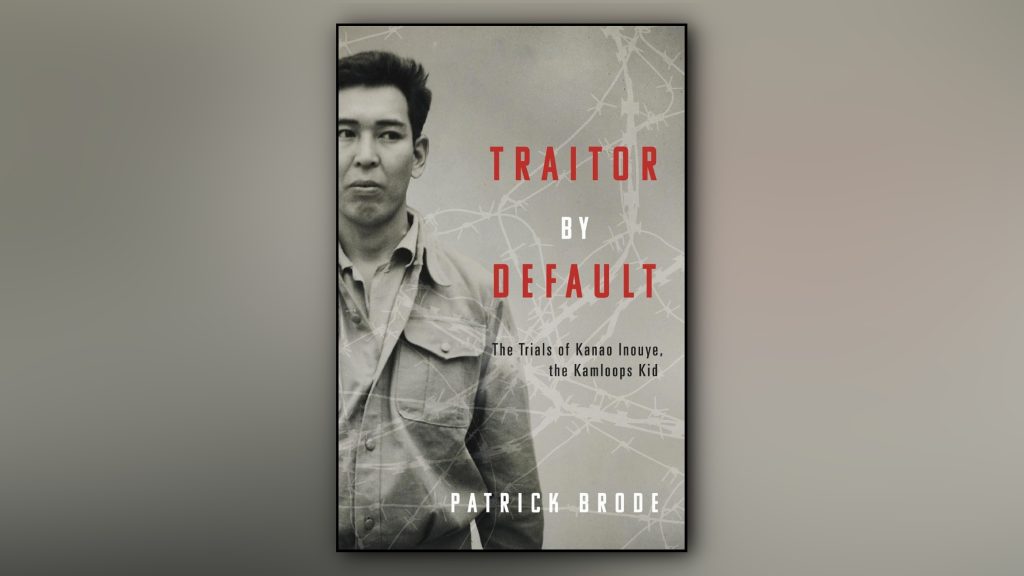The rise and fall of the Kamloops Kid: the story of a notorious B.C.-born war criminal is told in a new book

Posted June 23, 2024 12:17 pm.
Last Updated June 23, 2025 12:21 pm.
Kanao Inouye is one of only two Canadians ever to face prosecution for war crimes. In his role as an interpreter for the Japanese Army during the Second World War, he tortured prisoners of war and civilians. But it was high treason, not war crimes, that saw him marched to the gallows. Inouye is also believed to be the last Canadian to meet his end that way. Now, a new book looks at the strange, little-known case of the B.C.-born war criminal nicknamed “The Kamloops Kid” and “Slap Happy Joe” by Canadian POWs.
“I first came across [his story] in the 1990s when I wrote about Canada’s war crimes prosecutions at the end of the Second World War,” said Patrick Brode, author of Traitor By Default: The Trials of Kanao Inouye, The Kamloops Kid.
“I gave a brief account of it. But I decided to revisit it because it seemed to be some of it was off, was not correct. And I thought I should try and give the real story of what actually happened.”
Inouye was born in Kamloops in 1916. His father was a decorated Canadian war hero in the First World War. Before the war, he worked in the forest industry, specifically for a lumber company in Chase. Once he returned from combat, he moved his family, including Inouye and his four older sisters, to Vancouver. However, his father’s untimely death in 1926 made Inouye the “Koshu” or head of his family and he would eventually find his way back to Japan. By 1942 he was working as an interpreter for the Japanese Army, stationed at the Sham Sui Po prisoner of war camp in Hong Kong.
John Ackerman speaks with Patrick Brode
“The military called him up as a civilian to assist them, because they needed English speakers to [communicate] with this large number of prisoners they now held. So, he was sent down to Tokyo, and arrived there in September of 1942 and then all of a sudden, after several years of living in Japan, was cast in the midst of 1,700 Canadian POWs.”
It turns out Inouye still felt more than a little bitterness about the land of his birth.
“He held a lot of animosity against the Canadians that he’d grown up with, the white Canadians that he’d lived with in Vancouver as he as he came of age, and there were several stories, and none of them were really contradicted, that he felt that he had been slighted and ignored,” said Brode.
“He was on top, and all these white Canadians were on the bottom, and now it was payback time. And he was going to get it by being especially brutal to Canadians, beating them whenever he had a chance. So, that’s really beyond dispute. That’s the way he felt about things.”
By war’s end, 369 Canadians were liberated from Sham Shui Po. All prisoners returning from Asia were debriefed. In all, more than 1,000 depositions were received and, of these, more than 200 make specific references to “The Kamloops Kid.”
But Brode casts doubt as to whether Inouye committed all the crimes he was accused of.
“He did brutal things, he beat people, he tortured them, and he deserved to be harshly punished for that. No question about it. There was no evidence, by the way, though, that he ever actually killed anybody. Many other Japanese guards, for example, who clearly had killed many prisoners, got jail terms, but not him.”
However, after a lengthy trial, the whole thing was ruled invalid, because as a Canadian, and at that time a British subject, he fell outside the jurisdiction of the war crimes trial. Yet, he fought for and swore allegiance to the Japanese Empire.
“Is it possible that he was a citizen of both countries, and if he was British and Japanese when those two countries went to war, who do you owe your loyalty to? [It’s] still a bit of a question mark,” said Brode.
“More so these days, because so many people across the world have dual citizenships.”
Brode lays out how the treason proceedings which followed had a predetermined result, regardless of the documentation showing Inouye’s allegiance to Japan.
“He claimed that he was a Japanese that he had been registered since his birth as a Japanese citizen. He traveled under a Japanese passport. He served in the Japanese military. Even Canada’s senior officer in Asia said, ‘This guy has done everything possible to show that he is actually a Japanese citizen,'” he said.
“It was not a very neat trial. It was a situation where the judge seemed to be predetermined to get a result. And, by George, he got it.”
Brode hopes the reader is left with a better understanding of the difference between citizenship and loyalty.
“Just because you’re born in one country, ethnically or by culture, you [may be] more drawn to another country and you want to serve it. It could happen, and we really can’t judge those differences. I mean, it’s still a problem, determining which country you actually owe your loyalty to.”
Traitor By Default is a fascinating look at a still little-known chapter in Canadian military history.
Traitor By Default: The Trials of Kanao Inouye, The Kamloops Kid is published by Dundurn Press.








